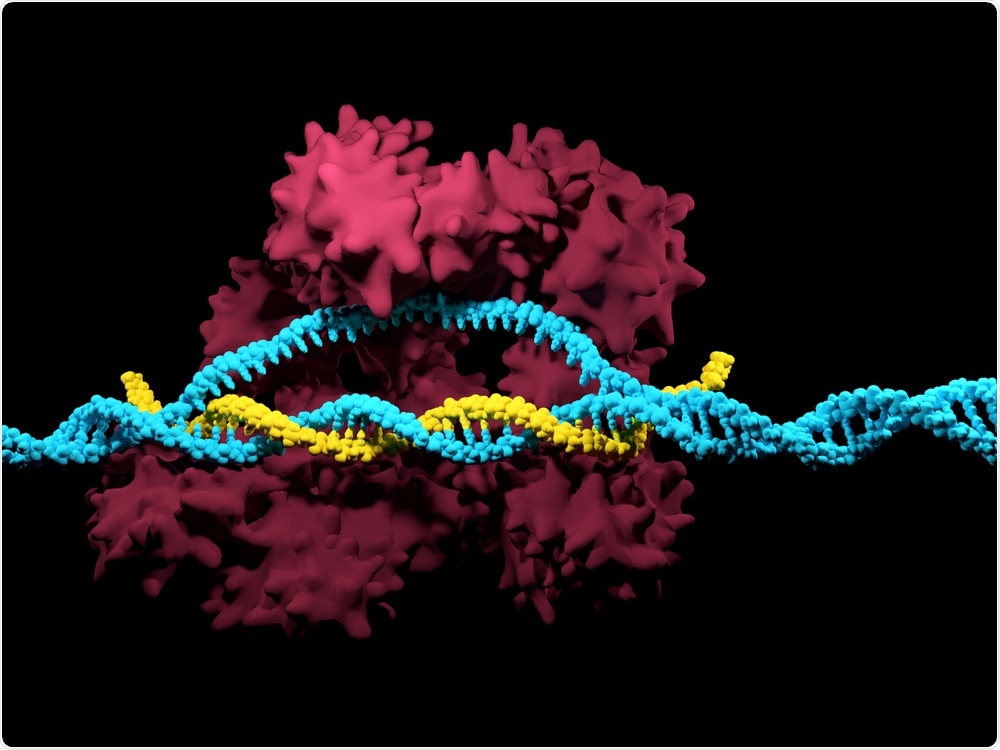An efficient and compact CRISPR-Cas system, known as CasMINI, can be widely employed for gene-therapy and cell-engineering applications as it is easier to deliver into cells. The results of the research appeared on September 3rd, 2021, in the Molecular Cell journal.

CRISPR. Image Credit: Meletios Verras/Shutterstock.com
This is a critical step forward for CRISPR genome-engineering applications. The work presents the smallest CRISPR to date, according to our knowledge, as a genome-editing technology. If people sometimes think of Cas9 as molecular scissors, here we created a Swiss knife containing multiple functions. It is not a big one, but a miniature one that is highly portable for easy use.”
Stanley Qi, Study Senior Author, Stanford University
The advancement of CRISPR-Cas systems for human cells has transformed genome engineering. These systems enable the enhancement of gene therapies for various genetic diseases.
However, their huge sizes often limit delivery into cells and thus hinder clinical applications. For instance, adeno-associated virus (AAV), a vector commonly used for in vivo delivery, has restricted packaging capacity of the payload (less than 4.7 kb), and several Cas fusion proteins are beyond this limit.
Hence, it is necessary to engineer highly efficient, compact Cas systems for the advancement of the next generation of genome-engineering applications.
A possible solution is Cas12f, also called Cas14, which ranges between 400 and 700 amino acids. The protein is less than half the size of currently employed CRISPR systems like Cas9 or Cas12a. However, so far, it was not clear if this compact protein can be used in mammalian cells.
Recent years have identified thousands of CRISPRs, which are known as bacteria’s immunity defense system. More than 99.9% of discovered CRISPRs, however, cannot work in human cells, limiting their use as genome-editing technologies.”
Stanley Qi, Study Senior Author, Stanford University
In the current research, Qi and his group applied RNA and protein engineering to the Cas12f system to create an effective miniature Cas system for mammalian genome engineering. Derived from archaea, the natural Cas12f protein and its single-guide RNA did not showcase detectable activity in mammalian cells.
Through the optimization of the single-guide RNA design and multiple rounds of iterative protein engineering and screening, the scientists created a class of Cas12f variants called CasMINI.
The engineered Cas12f protein variants together with engineered single-guide RNAs showed effective gene-regulation and gene-editing activity. The scientists revealed that CasMINI can drive great levels of gene activation when compared to those linked with Cas12a and permits robust base editing and gene editing. Furthermore, it is highly specific and does not create detectable off-target effects.
Here we turn a non-working CRISPR in mammalian cells, via rational RNA engineering and protein engineering, into a highly efficient working one. There were previous efforts from others to improve the performance of working CRISPRs. But our work is the first to make a non-working one working. This highlights the power of bioengineering to achieve something evolution has not yet done.”
Stanley Qi, Study Senior Author, Stanford University
The engineered CasMINI molecule is only 529 amino acids long. Thanks to such a small size, it is appropriate for a broad range of therapeutic applications. For instance, the CasMINI fusion proteins are appropriate for AAV packaging. Furthermore, CasMINI mRNA can be readily packaged into lipid nanoparticles or other RNA-delivery modalities, potentially enhancing cell entry.
The small size and non-human pathogen source make it less likely to cause immune responses when compared to large protein payloads.
Further research is necessary to optimize the efficiency of CasMINI for gene editing and base editing and also to investigate the performance of the system in vivo with various delivery modalities. The scientists intend to experiment with the system for in vivo gene therapy applications.
Qi states, “The availability of a miniature CasMINI enables new applications, ranging from in vitro applications such as engineering better tumor-killing lymphocytes or reprogramming stem cells to in vivo gene therapy to treat genetic diseases in the eye, muscle, or liver. It is on our wish list that it will become a therapy to treat genetic diseases, to cure cancer, and to reverse organ degeneration,” remarked Qi.
Source:
Journal reference:
Xu, X., et al. (2021) Engineered miniature CRISPR-Cas system for mammalian genome regulation and editing. Molecular Cell. doi.org/10.1016/j.molcel.2021.08.008.